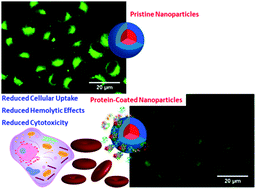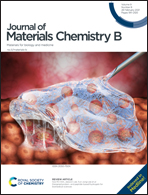Evidence of protein coronas around soft nanoparticles regardless of the chemical nature of the outer surface: structural features and biological consequences†
Abstract
The formation of biomolecular coronas around nanoparticles as soon as they come in contact with biological media is nowadays well accepted. The self-developed biological outer surfaces can affect the targeting capability of the colloidal carriers as well as their cytotoxicity and cellular uptake behavior. In this framework, we explored the structural features and biological consequences of protein coronas around block copolymer assemblies consisting of a common pH-responsive core made by poly[2-(diisopropylamino) ethyl methacrylate] (PDPA) and hydrophilic shells of different chemical natures: zwitterionic poly(2-methacryloyloxyethyl phosphorylcholine) (PMPC) or highly hydrophilic poly(ethylene oxide) (PEO) and poly(N-(2-hydroxypropyl)methacrylamide) (PHPMA). We demonstrated the presence of ∼50 nm protein coronas around the nanoparticles regardless of the chemical nature of the polymeric shells. The thickness is understood as the sum of the soft and hard layers and it is the actual interface seen by the cells. Although the soft corona composition is difficult to determine because the proteins are loosely bound to the outer surface of the assemblies, the tightly bound proteins (hard corona) could be identified and quantified. The compositional analysis of the hard corona demonstrated that human serum albumin (HSA), immunoglobulin G (IgG) and fibrinogen are the main components of the protein coronas, and serotransferrin is present particularly in the protein corona of the zwitterionic-stabilized assemblies. The protein coronas substantially reduce the cellular uptake of the colloidal particles due to their increased size and the presence of HSA which is known to reduce nanoparticle–cell adhesion. On the other hand, their existence also reduces the levels of cytotoxicity of the polymeric assemblies, highlighting that protein coronas should not be always understood as artifacts that need to be eliminated due to their positive outputs.



 Please wait while we load your content...
Please wait while we load your content...